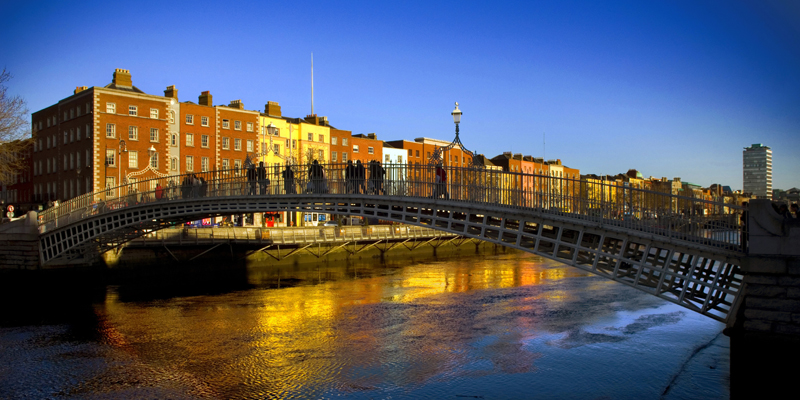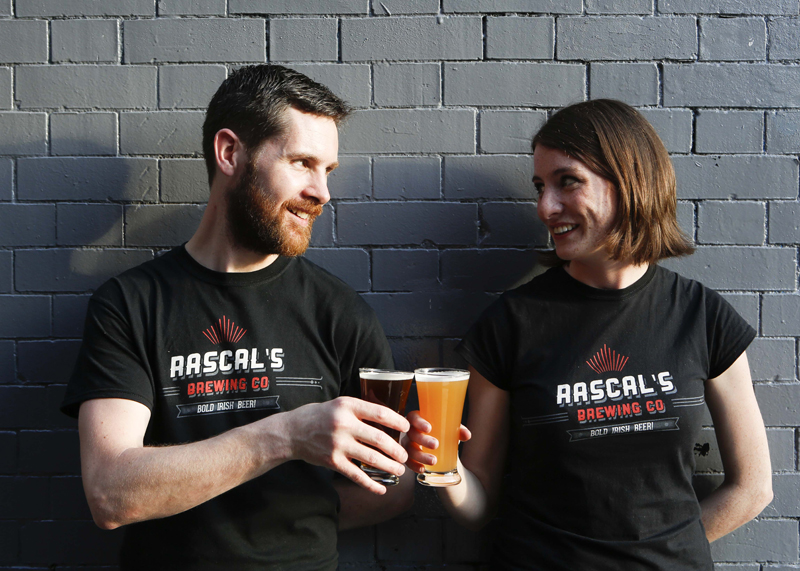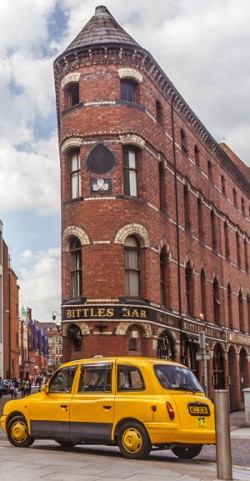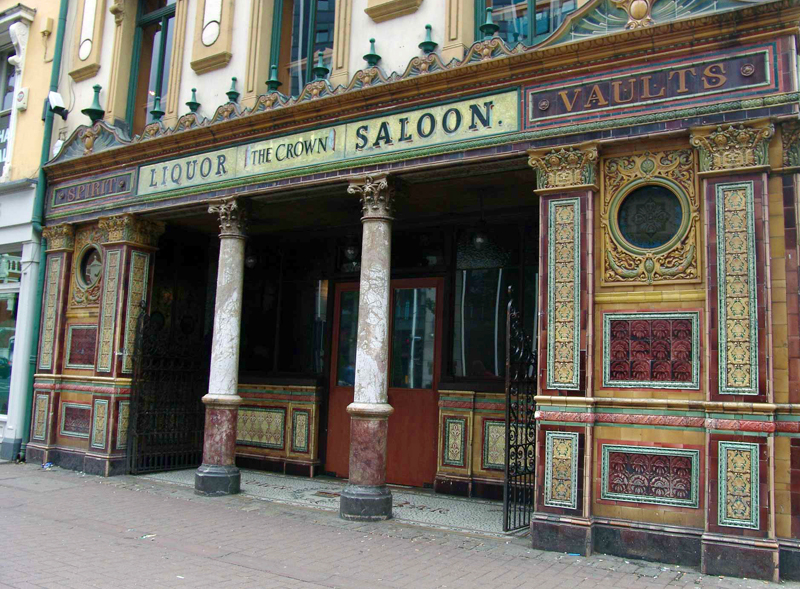Searching for the Perfect Pint in Dublin and Belfast
The Irish not only gave us dry stout porter, they also gave us classic drinking songs to sing whilst hoisting proper imperial pints (buy the MP3 of the Clancy Brothers’ “Beer, Beer, Beer”) and the full Irish breakfast (with “black pudding,” aka blood sausage, among the four breakfast meats on the plate) to sop up all those pints the next morning. There’s nary a city in America that doesn’t proffer Irish pubs, but certainly the most authentic experience comes from walking through the door of an actual Irish pub. That sounds like an invitation to offer a quick explanation about the Emerald Isle. There’s one island of Ireland; the Republic of Ireland makes up the larger, southern portion and contains the capital, Dublin, along with lush and literary locales such as County Cork and County Limerick. Northern Ireland—so named for its northeast corner of the island—is part of the United Kingdom of Great Britain, with Belfast as its capital. The two capital cities are two hours apart by train, and each crackles with the craic, Gaelic for fun, social atmosphere bolstered by good drink and great conversation.
One word to the wise. Beoir, a consumer group supporting native, independent breweries, has a great smart phone app, Beoir Finder, to lead you to great beer throughout your travels in Ireland.
Dublin
I finally made my pilgrimage to Dublin this past summer to attend the European Beer Bloggers Conference, which holds a sister conference in America, too. All “citizen beer bloggers” are invited to attend, so start your beer-centric Twitter account now as the easiest method of entrance and enjoy experiences like the following highlight of the conference. St. James’s Gate, better known as the Guinness Storehouse (St. James’s Gate), is the No. 1 tourist attraction in Ireland, not surprising given that the brand Arthur Guinness created in 1759 is a liquid icon the world over.
I now join the ranks of those who believe the perfect pint is pulled at the brewery. Once a thriving city within a city, the grounds cover more than 50 acres, but production is now centered in Guinness’ new facility, “Brew 4,” its fourth-ever brewhouse. It produces 1 million pints a day (note: 20-ounce imperial pints, not mere 16-ounce American pints), but such efficiency comes at a price. The facility had a price tag near €200 million (note: Euros, not mere dollars). Guests get the opportunity to pour their own pint—an activity that trained experts proclaim lasts precisely 119.5 seconds—and, if anything, it shows that there’s art in the pull to achieve the cascading nitrogenated bubbles that lead to a symmetric foam dome atop each creamy, roasty stout.
Sometimes visiting the Guinness Storehouse yields small-batch beers—10 hectoliters is barely larger than nanobrewery scale—and the vanilla-infused Night Porter I sampled was divine.
One mantra I kept hearing about Irish beer drinkers is that they’re brand-loyal. Perhaps this explains why there are only about 60 craft breweries throughout the island, 39 of which sprouted up since 2013. But thanks to Beer Ireland, an organization that supports native craft brewers, sales of indie brands grew by 35 percent last year, a much greater gain than in the American craft beer market—if only in terms of growth yet nowhere near the volume.
Trouble Brewing, founded in 2010, is deemed the godfather of Irish craft brewing. Its Sabotage IPA, brewed with hops sourced from around the globe, clocks in at 5.5%, which, even though that nearly qualifies as a session IPA stateside, is relatively strong around here.
Dublin native and The Tale of the Ale beer blogger Reuben Gray organized a killer pub crawl that would serve all beer travelers well. Along this progression of pints we hit The Norseman (28E Essex St., formerly Farrington’s) set in a 120-year-old Victorian building. It’s where I made my favorite discovery, in terms of creativity and flavor, the Ginger Porter from Rascal’s Brewing brewed in Rathcoole and increasingly available around Dublin. The beer’s slight kiss of ginger root and light touch of cacao nibs ensure it’s a porter first, with the culinary touch oozing in only at the finish, and at 4.8%, it’s no one-pint pony. Like Rascal’s, another new brewery from an area homebrewer is Black Donkey, whose excellent Sheep Stealer Saison—not many funky Belgian yeast strains are found in Irish beers—can be found in bottles. One more great find at the Norseman was Eight Degrees Brewing (EightDegrees.ie) Amber Ella, an American-style red ale but with Aussie hops.
Like this literary city steeped in James Joyce (whose century-old book of short stories, The Dubliners, should be required reading for any visit alongside anything from Lonely Planet), I’m afraid I didn’t start at the beginning. The pub crawl began at The Brew Dock (1 Amiens St.), one of the Galway Bay Brewery’s nine tied houses but with a beer list that goes far beyond the house brands, both on tap and in bottles. Being Britain-adjacent, cask ales are always a great call, and the Galway Bay Stormy Port Irish Porter pours ultra-black with a tan head. Although the coffee astringency is apparent, the velvety cask version makes for a super creamy head and mouthfeel. If the pub appears too crowded, head upstairs for more tables and elbowroom.
From there, it’s less than a half-mile walk to J.W. Sweetman (1-2 Burgh Quay), the only proper brewpub in Dublin that’s housed in a three-story tavern from 1808. Situated on the River Liffey, it has a definite party atmosphere, but that just means more friendly revelers to enjoy a few pints with. Here again, I recommend the Porter on cask.

The Porterhouse Temple Bar offers a quintessential Irish pub experience that’s authentic, not contrived.
Amble from the Eden Quay due west along the Liffey toward the Wood Quay, skipping much of the bachelor and bachelorette party central that is Temple Bar, and you’ll find yourself in The Porterhouse Temple Bar (16-18 Parliament St.), one of the brewery’s three tied houses in Dublin (yes, The Porterhouse in Manhattan is in this same line of pubs). This spot offers a quintessential Irish pub experience that’s authentic, not contrived, with friendly bartenders and friendlier bar mates. Continuing the stout and porter kick, Porterhouse offers three—Wrasslers 4X Full Stout, which tastes too rich to only be 5%; the brewery’s best-selling stout, plainly called Oyster Stout for its use of oysters during conditioning; and Plain Porter, the most celebrated beer in its portfolio. For dry porter fans, this may be the holy grail in the search for the perfect pint.
A quick word about lodging, since that’s key to any beer trip, is that right around the corner is the Clarence Hotel (6-8 Wellington Quay), co-owned by U2’s Bono and The Edge. It provides nice, quiet rooms in an otherwise loud neighborhood that’s centrally located.
If you still haven’t found what you’re looking for, a short walk south leads pub crawlers to the Bull & Castle (5-7 Lord Edward St.) with a big beer list and huge steaks. But at this point in the expedition, it’s wise to gobble down some fish and chips, and Gray said the line outside the nearby Leo Burdock (2 Werburgh St., Christchurch), doesn’t lie. The “chipper” itself is near the gothic Christ Church Cathedral, which makes for impressive scenery when lighted at night.
Another of Gray’s recommendations is 57 the Headline (56/57 Lower Clanbrassil St.). It not only boasts the most Irish craft beer on draft with 20 taps, but also serves a unique IPA-tempura-battered rendition of fish ’n’ chips along with ginger and mint crushed peas. Rather than a fine pint of O’Hara’s Irish Pale Ale from Carlow Brewing, they suggest pairing it with 5 Lamps Lager from another of Dublin’s new breweries. Besides, the O’Hara’s to look for is Leann Folláin, which translates to wholesome stout, and it truly is a great imperial stout, though here that means 6%, not 10 to 12. The coffee notes are less of roasted beans and closer to their cherrylike fruit cascara. A finer treat, if you can find it, is the Irish whisky-aged version, and I also managed to try a Jameson Whisky barrel stout from Franciscan Well. This was a first for both brewery and distillery, and the resulting Jameson Stout proffered a vanilla, oak and, yes, whisky essence that should make it an ongoing proposition. Oh yeah, the Headline’s whisky list is impressive and could lead to a dangerous night if beer-and-a-shot is your thing.
Lastly, “a visit to the Phoenix Park is a must,” said Gray. “It makes Central Park look like a backyard.” Alas, the 707-hectare park (1,750 acres) features no beer garden, but, noted Gray, there’s the aptly named pub, The Hole in the Wall (Blackhorse Ave.). “Because you literally access it by a hole in the wall that surrounds the park.” Here you can find several draft beers sectioned into porters, lagers and pales, and some of the best wings in Dublin. The Irish may not have America’s wild diversity in beer styles, but they’ve appropriated our love of Buffalo wings, for sure.
Day Trip: Howth and Bray
Dublin’s fantastic, but what’s a trip to the Emerald Isle without witnessing its glorious, craggy coast? An easy 25-minute train ride leads to the village of Howth (where you may spot U2 drummer Larry Mullen) on the north peninsula of the Dublin Bay. Hike to the Baily Lighthouse, then enjoy lunch of Shepherd’s Pie with McGrath’s Pale Ale-braised beef and a bottle of either the pale or sharp, exquisite McGrath’s Irish Black Stout that tastes twice as full as its 4.3% ABV would imply. The pub is the place for a crowd of mostly local seniors who laugh at each other’s jokes while all quaffing a pint and the barkeep greets ’em all by name. Howth is actually closer to Dublin Airport than the center of Dublin. Having said that, the coastal village of Bray, southward along the Irish Sea, results in possibly more stunning scenery. Bray is also home to the original Porterhouse (Strand Road) replete with a beer garden overlooking the sea, stellar house beers and a quaint inn.
Belfast
The allure of all things Titanic is so great, there’s an entire Titanic Quarter erected on the site of the former shipyard where the fateful ship was built. To partake in a less morose tradition, for those feeling peckish, there’s afternoon tea at the grand, Victorian Merchant Hotel (16 Skipper St.) involving finger sandwiches, scones and a spot of tea. Even nonhistory buffs can enjoy an array of delicacies at St. George’s Market (12-20 E. Bridge St.) with tempting tidbits and as many as 248 food stalls stocked with local provisions during the Variety Market on Fridays. But this is about diving into Belfast’s beer culture, so Steve Lamond, resident of County Tyrone in North Ireland, who blogs at BeersIveKnown.blogspot.com, suggested an equally awesome pub crawl comparable to the one I tackled with him in Dublin.
He first noted that there are 15 brewing outfits in the North—Hilden is the oldest, Whitewater (WhitewaterBrewing.co.uk) is the most widely available, Ards (Facebook.com/ArdsBrewing) is among the smallest—with at least three more planned in the coming months. “By far and away the best selection of Northern Ireland beers, on-tradewise” said Lamond, referring to the distinction of on-trade (beer sold on premise such as at a pub) and off-trade (retailers selling packaged beer for take-away) is at Bittles Bar (70 Upper Church Lane) mostly in bottled format including the output from the tiny, half-barrel brewery Ards. A block from the River Lagan, Bittles occupies a corner site of a triangular building, what we’d call a flatiron in America, and is well-appointed with political paintings, Irish whiskies and everything else you need for a great night out.
A half-mile walk away is the other “must visit,” The Hudson (10-14 Gresham St.), “which hosts a monthly beer club … and does a decent bowl of seafood chowder.” Note that the pub’s motto is “Whiskeys, Ales & Disco,” so that second-story dance club is very real.
About another half-mile walk south brings you to the “Victorian gin palace splendor” of The Crown (46 Great Victoria St.), a historic bar that’s owned by the National Trust yet managed by Nicholson’s Pubs. This is a great spot for cask beer from across the UK. One intriguing item in what it calls its Ale Library is Boilermaker, described as a Welsh Whisky IPA from Brains Craft Brewery in Wales. Not only is the American-hopped ale (Cascade, Simcoe, Chinook) aged on whisky-soaked oak chips, the whisky itself also is distilled from the wash brewed by Brains.
One more 10-15-minute walk and you’ll arrive at Molly’s Yard (1 College Green Mews), a great spot for dinner, especially since ordering food is required to imbibe. Owned by the Hilden Brewery, which as Lamond pointed out is a short train ride away south in Lisburn and has another nice restaurant on premise, Molly’s Yard serves quality meals from fresh fish to dry-aged steaks. Those meals would go great with Molly’s Chocolate Stout, which is Lamond’s recommended beer, and Twisted Hop, an Irish pale ale, is one of the highest-rated beers around.
Day Trip: County Tyrone
To local expert Steve Lamond, the best food in Northern Ireland is at The Brewer’s House (TheBrewersHouse.com; 73 Castlecaulfield Road) in the quaint village of Donaghmore, about an hour by car from Belfast. Here, head chef Brian McMonagle, said Lamond, “is a seafood specialist, so there’s always plenty of fresh fish,” and a beer-battered fish of the day. He’s also the namesake behind treats listed on the menu such as Brian’s chorizo sausage featured in the baked tartlet (vegetarians will find plenty to eat, too). Best of all, it recently opened its own brewery, Red Hand Brewing (Twitter.com/RedHandBrewer) whose premier beer, Pale Ale, Lamond called “a decent homage to Sierra Nevada Pale Ale.” Also look for a cask and keg tap dedicated to Northern Ireland brews, usually Whitewater’s excellent Hoppelhammer IPA and house ciders from Mac Ivors Cider Co., a bit farther south in County Armagh.
Brian Yaeger
Brian Yaeger is the author of Red, White, and Brew: An American Beer Odyssey and the forthcoming Oregon Breweries.





It is the nature of beer drinkers here in San DIego to prefer visits to actual breweries over brew pubs. Our best experinece in Ireland last fall was a visit to Blacks’ Kinsale Brewery. Get it from the source!
Ireland has no law allowing tasting rooms; to legally serve beer at a brewery, you must buy a full pub license for €80k+.
Irish beer drinkers wish we had it like Portland or SD.
Good detailed survey here.
While the onset of craft breweries apart a few pioneers (some mentioned above) was delayed, the country is making up for it. Before long I believe Guinness will feel obliged to bring back naturally-conditioned stout. “Dry stout” as a style is in latter decades essentially a pasteurized, malt-and-adjunct product (I believe something like 10% roasted barley, 30% raw barley, the rest malt). I am sure it is a decent pint at the brewery and in Dublin too but from a beer palate viewpoint – which is all that matters, IMO – anyone familiar with Guinness’s history would support re-introduction of an-all malt, naturally-conditioned product. It could be done under an imprint (Guinness Historical or a name like that), possibly in a separate location functioning as a brewpub. I think this is inevitable, but we will see.
Gary